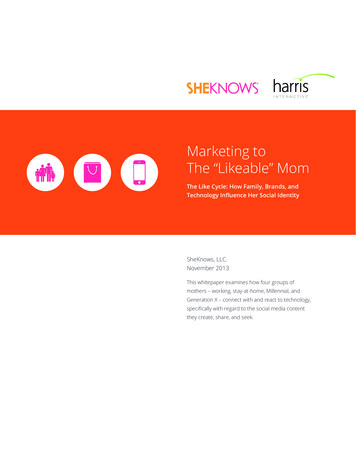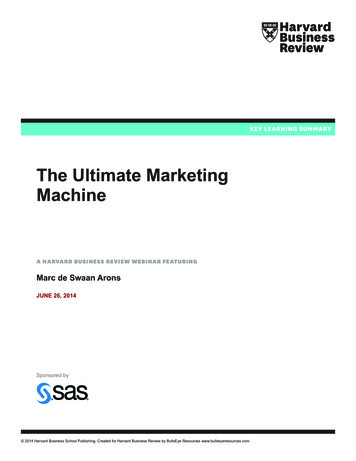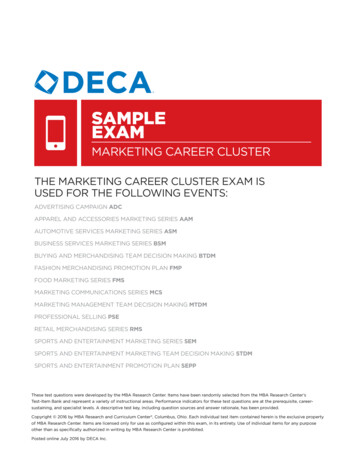
Transcription
Marketing toThe “Likeable” MomThe Like Cycle: How Family, Brands, andTechnology Influence Her Social IdentitySheKnows, LLC.November 2013This whitepaper examines how four groups ofmothers – working, stay-at-home, Millennial, andGeneration X – connect with and react to technology,specifically with regard to the social media contentthey create, share, and seek.
introductionkey findingsOften identified as the social gender, women are knownBy employment statusto talk, touch, and connect more than men. Over thelast decade, advancements in technology, and especially social networks based on number of followers,the rise of social networks, have enabled women to scaleand upload a variety of photos and videostheir connections and to thrive in online communities.showcasing their busy lives.Women have learned to develop trust and virtualintimacy with their social circles based on sharedWorking Moms (WMs) dominate across most Moms consider technology to be a welcomeinterests, experiences, and values. They are sharing,parenting tool, but Stay-at-Home Momsspeaking, and listening more than ever, and doing so(SAHMs) are the least anxious about themore rapidly and at greater scale.dangers it potentially brings.How are these new social behaviors impacting women’sBy generationidentities? SheKnows is dedicated to serving women’s With tighter circles and fewer profiles to juggle,lifestyle passions online. As such, we are interested inGeneration X Moms (GXMs) are less likely toidentifying the strengths and challenges that a scaledbe overwhelmed by technology than Millennialsocial identity creates. As we embarked upon a studyMoms (MMs).of women’s online behaviors, we found that technologyand social feedback play critical – and sometimesconflicted – roles for mothers. We chose to hone in onmothers’ social identities and use of technology becausetoo often, moms are characterized as a single consumer. Millennial Moms (MMs) are firmly entrenchedin the “like-cycle,” more actively focused oncultivating their online identities, and morecollaborative in defining themselves.Our report illustrates that there are actually severalmom profiles when considering online social expressionand use of technology. We were particularly interestedin the differing perceptions of working motherscompared to those who stay at home, and of MillennialMoms compared to Generation X Moms. While no twomothers are the same, and these groups are clearly notmutually exclusive, segmentation allows us to betterunderstand what motivates, inspires, and concernsthese archetypes.SheKnows and Harris Interactive:Marketing to The “Likeable” Mom SheKnows, LLC. All rights reserved.1
MethodologyThe study took the form on an online survey fieldedbetween July 31 and August 15, 2013. The overallsample was comprised of 1,007 women betweenthe ages of 18 and 65, living in the United States. Allqualifying respondents indicated prior usage of anelectronic device and having consumed digital content,as well as not currently working in a sensitive industry.From the 1,007 women, 280 women born between 1966and 1977 were classified as Generation X. Of those, asubset of 186 were identified as mothers of childrenunder the age of 18 living at home.Millennial Moms are more active on socialnetworks, feeling more pressure to connectthan their Generation X counterpartsMost Millennials don’t remember what life was like in thepre-digital world. These digital natives are inherent earlyadopters of new technology, particularly with regardto advancements in mobile and emerging social mediaplatforms.But can perpetual connectivity make life feeloverwhelming? Over half of Millennial women (56%)say yes, which is a 12% increase over women in theThree hundred and thirty women born between 1978and 1995 were classified as Millennials. Of those, asubset of 152 were identified mothers of children underthe age of 18 living at home.general population, and a 30% increase over womenwho are part Generation X. With the majority feelingoverwhelmed by social connectivity, it appears that thedigital natives are a bit restless.full-time or part-time job were classified as Workingcan“ Technologymake my life feelMoms, while 147 women with at least one child whooverwhelming”Additionally, 222 women with at least one child and a56%Millennial Women43%were not employed at the time of this survey wereGeneration X Womenclassified as Stay-at-Home Moms.Figure 1All bases, samples and sub-sets have been weighted toFindings suggest that Generation X women perceivebe representative of women in the general population.the advantages of digital connection more positivelythan their Millennial sisters. This makes sense, as olderwomen recall childhoods when pay phones linked themgraphics keyto parents, paper maps were the best navigation toolsavailable, and work, for their parents, occurred onlyoutside of the home. Of course they still appreciate theMillennialWomenMillennialMomsWorkingMomsadvent of technology and particularly digital connectivity.They’ve got just as many devices in their homes asMillennials. Eighty-three percent of Generation Xwomen believe technology helps them achieve a betterGeneration XWomenGeneration XMomsSheKnows and Harris Interactive:Marketing to The “Likeable” MomStay-at-HomeMomswork/life balance, as do 78% of women in the generalpopulation and 76% of Millennials. SheKnows, LLC. All rights reserved.2
Dessert, sex, smartphone. or TV –which would they give up?Motherhood can arguably be one of the greatestchallenges to work/life balance. Millennials begin43% Millennial Moms46% Generation X Momsto appreciate technology more when they become43% Working Momsmothers, as multi-tasking becomes a necessity. Most39% Stay-at-Home MomsMillennials had access to cell phones in college, and22% Millennial Momsmany in high school, so they are far less accustomed17% Generation X Momsto life without their lifeline. As such, MMs exhibit azealous attachment to smartphones, stronger than thatof GXMs. While the vast majority of both MMs (80%)and GXMs (75%) who are smartphone owners admit to24% Working Moms16% Stay-at-Home Moms13% Millennial Moms17% Generation X Moms16% Working Momssleeping with their phones in their bedrooms, GXM’s22% Stay-at-Home Momsare less likely to actually use them there. Less than half22% Millennial Moms(49%) will check personal email or social networks in21% Generation X Momsbed, compared to 75% of MMs.17% Working Moms23% Stay-at-Home MomsFigure 2But just how important is the smartphone? While allmoms would find it very difficult to give up their phonesfor six months, more MMs would rather give up sex, TVor dessert than their smartphones if forced to choose.And what about differences in employment? It isno surprise that a quarter of WMs also are checkingpersonal email or social networks on mobile whileactually mobile – walking. However, the office is themost common place to catch up, suggesting that manyare willing to preserve digital activities, whether work orpersonal, at work and away from home.WMs need their lifeline more than SAHMs, with only16% choosing to give it up over dessert, sex or TVcompared to 22% of SAHMs. And perhaps less time athome makes them value their TV time – almost as fewWMs chose to keep their TVs as their smartphones.Conversely, SAHMs may value the time their employedpartners have at home, as they are less likely to give uptheir sex lives.SheKnows and Harris Interactive:Marketing to The “Likeable” MomMillennial Moms maintain multiplesocial identitiesPerpetual connectivity is naturally correlated with MMs’hyper-activity on social networks. Their openness tonew platforms has resulted in far more social profiles tomanage than GXMs. They are more actively participatingon YouTube, Google , Instagram, and Tumblr. Whilemanaging so many disparate online personas, they’realso cultivating large followings across several networks.MMs have nearly four times more Instagram followersand five times more Tumblr followers than GXMs,underscoring MMs early adoption of newer networks.When it comes to connections, WMs’ networks are largerthan SAHMs across almost all platforms. Predictably,WMs lead on LinkedIn; however they also dominate onFacebook, with 36% more friends, as well as more thantwice the Twitter followers, four times the Instagramfollowers, and nearly fifteen times the Google contacts. SheKnows, LLC. All rights reserved.3
Reasons to visit a brand’ssocial media pageAmount of friends/followerson top social networks59%71%57%47%27%Find dealsMillennial MomsWorking MomsGeneration X MomsStay-at-Home MomsResearch18%Complainabout serviceFigure 4Having children does not greatly impact GenerationX women’s motivation to check out brand pages. ForMillennials, however, there are two noticeable shiftsthat occur with the advent of motherhood. Fifty-onepercent of MMs start using social media for research,a 16% increase over the generation overall. This couldrepresent the maternal impulse to get both informationand peer support simultaneously.Working MomsStay-at-Home MomsFigure 3Both generations of moms are as likely to visit brands’social media pages, but for GXMs, that’s where theGeneration X Moms keep their circles tight;Millennial Moms open them up to brandsengagement ends. They are not arbitrary brandDue to the influx of advertising on social networks,than the average for all women between 18 and 65.users can now decide whether they’re willing to engagewith brands alongside their families and friends. Thenumber one reason for any mom to visit a brand’s socialmedia page is to find a deal, with SAHMs reporting thegreatest majority at 71%. WMs are motivated to usesocial media to find brands while in the considerationphase and also post-purchase. Fifty-seven percent aresupporters, averaging 13.7 brand followings, 2.5 lessJust below one-third are influenced to follow brands byads targeted to their interests, and 30% consider howthe brand makes them feel. About a quarter say that arecommendation from a friend may be a good enoughreason to follow a brand. In short, GXM’s follow brandsthat appear to understand them. These influencers aresimilar to Generation X women overall.researching products and services on social media.Twenty-seven percent will use social media to contactcustomer service and complain. Less than 20% ofSAHMs use this channel to voice grievances.SheKnows and Harris Interactive:Marketing to The “Likeable” Mom SheKnows, LLC. All rights reserved.4
In contrast, MMs follow a whopping 22.5 brands. WhileMMs understand that brand advertising is a part ofMMs were eagerly following brands before havingmany media experiences. However they prefer tochildren, the reasons to follow a brand remain thechoose the brands with whom they engage. As thesame with one conspicuous exception. While about“opt in” generation, they know their rights and have35% of Millennials think about how brands makelittle tolerance for irrelevant advertising. Despitethem feel when deciding whether to follow them, 43%the purported desire for relevance, re-targeting canof MMs say it’s a consideration, an increase of 23%.go too far. There’s a fine line between being servedPersonal identity becomes more closely tied to brandmeaningful advertising and feeling like you are beingengagement.watched. Across the generation of Millennials, 87% are“creeped out” that ads can track them online comparedAverage number of brandsfollowed on social networksto 76% of Generation X women and 84% of women ingeneral. Thirty-six percent of MMs concede that theyare influenced by effective targeting on social media.Again, indicating their understanding of the dynamicsof media. Most advertisers simply haven’t yet masteredthe un-creepy (organic) relevance trick, leaving their22.5young consumers rather irritated.Millennial MomsEasy access to social media can boost traditional adexposure. With multiple web-connected devices readilyavailable at home, moms are pairing TV time (to varyingdegrees) with activity on “second screens,” such as13.7Generation X Momslaptops, tablets, or smartphones. Many are likely toFigure 5connect digitally to learn more about a program theyare watching on TV. A MM is 17% more likely than aWhat’s surprising about MMs’ increased roster of brandGXM to use a second screen to learn more about asupport within social networks is that the segment is farshow, though they are relatively even in their interestmore annoyed by ads that appear on their social feedsin commercials. These behaviors differ by employmentthan members of Generation X. Yet they are receptivestatus.to relevant advertising and are more willing to “opt in” toparticipate or engage with brand campaigns.SheKnows and Harris Interactive:Marketing to The “Likeable” Mom SheKnows, LLC. All rights reserved.5
They “friend” peoplenot known in real lifeWorking Moms are more likely to actively seek secondscreen information. Though they typically have the samenumber of devices in their homes, WM’s are twice aslikely as SAHMs to use second screens to learn moreabout shows, and nearly two and a half times as likely todo so to learn more about commercials.51%36%33%Millennial WomenSecond screen activityWorking Moms areWorking Moms aremore likely to use a secondscreen to learn moreabout TV shows thanStay-at-Home Momsmore likely to use a secondscreen to learn more aboutTV commercials thanStay-at-Home Moms2x38%Millennial Moms2.5xGeneration X WomenGeneration X MomsFigure 6GXMs are not only more restrictive than MMs with thenumber of brands they allow to penetrate their socialnetworks, they are also relatively conservative when itFigure 7Working Moms can do it all or so say theirsocial media profilescomes to allowing unknown people into their spheres.Since 75% of women use social media primarily to keepFewer than 35% would ever accept or send friend/up with family and friends, motherhood predictablyfollower requests from a person that they haven’t met inreinforces the desire to upload and share content, albeitreal life, making them only slightly more private than thewith varying frequencies. Just over half of Millennialsgeneration overall.overall, and 61% of MMs, share content at least once aday. They believe in posting all meaningful life momentsIn contrast to GXMs, motherhood triggers Millennialto social platforms, and the arrival of offspring spawns awomen to open their networks beyond what thevolume of such experiences.offline world defines as a “friend.” Sixty-two percentof Millennials only accept and send friend/followerFrequency of creating and sharing content for GXMsrequests to people they know in real life, not much lessmirrors the generation overall, but the content itselfthan Generation X. When motherhood hits, Generationtransitions. Seventy-nine percent of GXMs who shareX closes ranks by inching up to 67%, meaning only aphotos or videos give their children center-stage.third are opening up their networks. MMs open up with51% accepting connections from individuals onlyknown online.SheKnows and Harris Interactive:Marketing to The “Likeable” Mom SheKnows, LLC. All rights reserved.6
Content regularlyshared on social mediaMMs may also be sharing more and more often, butnot with the same content shift as GXMs. MMs areKid(s)less likely to transform their social media profiles intoFriendsexclusive celebrations of their children. Most photosVacationsand videos are still of their friends, just as they are forthe generation overall. Vacation and kids are tied forsecond place. Other facets of their lives are stronglyrepresented, including subjects such as significantothers, parents and even celebrities. Food remainsa relatively popular subject, with 40% of MMs postingphotos of food they’ve made, and 19% sharing shotsof meals they’ve ordered at restaurants. Perhaps thestrongest indication of many MMs striving to keep theirindividual identities intact is their propensity to post“selfies” – 42% of MMs are featuring self-portraits onsocial media, just as many as Millennials overall.Similarly, WMs curate a variety of content on socialmedia. Sure, 69% feature their kids, but 55% sharevacation highlights, and 49% showcase their friends.Perhaps in an effort to show that they really can do it all,35% show off their skills in the kitchen by sharing mealsthat they’ve prepared. It seems evident that WMs areusing social media to document and validate their familytime. And finally, their content can incorporate videowith 33% of WMs reporting that they have uploadedvideos in the past three months, 138% more thanSAHMs.Significant otherPet(s)SelfiesFood I madeHomeParentsFood I orderedCelebritiesMillennial MomsGeneration X MomsKid(s)FriendsVacationsSignificant otherPet(s)SelfiesFood I madeHomeParentsFood I orderedCelebritiesSAHMs are the most likely to share kid content, primarilyWorking Momsthrough photos, but they haven’t forgotten their friends.Stay-at-Home MomsWith 85% sharing photos of kids and 61% sharingFigure 8photos of friends, they celebrate people over the thingsand places in their lives.SheKnows and Harris Interactive:Marketing to The “Likeable” Mom SheKnows, LLC. All rights reserved.7
The research shows MMs and WMs strive to maintainWhile much of social media “like-cycling” is positive,diversity of content, representing their unique personas,enabling moms to give and receive peer support at theas both as individuals and as mothers.push of a pad, some moms can also feel alienated byviewing their peers’ social activity. Millennials are slightlyMillennial Moms like to be liked and tolike othersAfter sharing on social media, WMs are most driven byfeelings of validation when their followers like, commentor spread the content, followed by MMs, then GXMs.SAHMs care the least, even less than the generalpopulation of women.more likely to feel depressed after reading their socialmedia newsfeeds. They are also more likely to feelinadequate when reading updates. Motherhood seemsto boost mood and self-esteem. While a quarter ofMMs admit to feeling inadequate, that’s a 19% decreaseto the generation overall. GXMs are not only less likelyto share these sentiments, but they feel better than allwomen when they engage online.Since smartphones play a more prominent role in MMlives, and perpetual feedback is a habit, it’s only naturalthat they are checking for it more often. Ten percentadmit to doing so every few minutes and 22% seek areaction every hour.people’s“ Othersocial mediaupdates leave mefeeling inadequate”can be an issue for WMs, with 26% saying it is importantto receive; 16% of SAHMs say the same. GXMs place abit more value on feedback than MMs. But what if thefeedback is negative? Whether they are moms or not,Working Moms30%Stay-at-Home MomsWhile getting any feedback is just as important (orunimportant) as before motherhood, trends show that it21%31%25%19%20%Millennial WomenGeneration X WomenMillennial MomsGeneration X Momsabout 75% of Generation X women are bothered byFigure 9negative feedback, but less than one-third will concedethat such feedback will impact what they share in theEmotions also run high regarding relationships and howfuture. MMs are much more sensitive to negativethey are reflected on social identities. Despite beingfeedback, with 85% admitting to being bothered by it.younger, more MMs said they have exes than GXMs,Of those, slightly more than a third would alter their75% versus 61%. And of those MMs with at least onefuture behavior. Millennials are comfortable with thefailed relationship, 28% will view their exes’ profilesfeedback loop and feel less defensive about what theyon social media at least once a month. MMs are alsohear from peers. As the collaborative generation, theythe quickest to change their social media relationshipsare inclined to integrate feedback into their lives morestatus and delete photos following a breakup, with 32%seamlessly than the more confrontational Generationdoing so the day of, compared to only 16% of GXMs.Xers.SheKnows and Harris Interactive:Marketing to The “Likeable” Mom SheKnows, LLC. All rights reserved.8
MMs are also the quickest to change their social mediaSince they are used to being ever-connectedrelationships status and delete photos following athemselves, MMs are also less likely to fear that theirbreakup, with 32% doing so the day of, compared tochildren will show signs of technology addiction.only 16% of GXMs.Seventy-two percent of GXMs state this as a concern,although they too struggle with discouraging usage.Mothers control their children’s use oftechnology; while worries exist, its long-termimpact is perceived as positiveGXMs feel much more pressure to keep up with theJoneses when it comes to their kids’ devices, while atthe same time worrying that an attachment to deviceswill prevent their kids from playing outside. HavingThe majority of moms believe using technology makeshad parents that gave them simple warnings, such astheir children smarter; an average of 68% of MMs, WMs,don’t sit too close to the TV, GXMs are more generallyand SAHMs agree. The largest tech advocate is actuallyconflicted than MMs with regard to how much, howGXMs, with 76% recognizing the lifelong benefits ofoften, and how many for their children.being a digital native, perhaps because they experienceda steep learning curve first-hand. Moms are even moreInterestingly, the mom that worries the least overbullish when it comes to computer-based activities,whether technology will hinder children’s ability toincluding video games. Seventy-five percent of WMs,communicate face-to-face is the SAHM. Not only is77% of SAHMs, 80% of MMs, and 81% of GXMs believeshe able to be more of a physical presence in herthese activities can help develop important skills that arechild’s day-to-day life, but she may also have greaterkey to their child’s success in school and will play a rolecontrol over his or her environment. SAHMs also arein future career advancement.not as concerned that technology will replace outdooractivities.Mothers are also sensitive to new parenting concernssurrounding their children and technology, keeping aWhen thinking about the dangers of being online at anwatchful eye on their exposure. For instance, 36% ofearly age, WMs are twice as likely as SAHMs to worryMMs worry that technology can lower their child’s self-that their children will fall victim to cyberbullying. Itesteem. That’s a 14% increase over GXMs.is possible WMs feel more strongly about this topicbecause they are unable to see their kids during theYet MMs are not likely to discourage an early relianceworkday.on mobile. As the younger generation of moms, theypredictably have younger children, with 28% caring forbabies or toddlers compared to 16% of GXMs. Fivepercent of MMs provided a smartphone or tablet totheir kids before the age of two, ensuring they will neverknow life without a touch pad or a community cloud.SheKnows and Harris Interactive:Marketing to The “Likeable” Mom SheKnows, LLC. All rights reserved.9
Concerns about technology’simpact on kidsTechnology is preventingmy child from exercisingor playing outside.Technology is hinderingmy child’s ability tocommunicate face-to-faceMy child may be thevictim of cyberbullyingWorking MomsStay-at-Home MomsFigure 10Over half of each group uses technology to entertaintheir kids. Three-quarters allow technology to occupythe kids so that they can focus on other tasks. As aresult, about half of all moms ultimately feel guilty abouttheir reliance on technology as a parenting crutch.Despite these legitimate concerns, general sentimentstoward technology and parenting are overwhelminglypositive for all moms. GXMs are even more enthusiasticthan MMs toward technology as a parenting tool, likelybecause they have older children that they need to keeptrack of and/or help with schoolwork.SheKnows and Harris Interactive:Marketing to The “Likeable” Mom SheKnows, LLC. All rights reserved.10
conclusionWomen are redefining what it means to be a mom. To Stay-at-Home Moms are deal-driven, using socialengage with this influential group, it is important tomedia to discover discounts and promos. Theyunderstand what shapes her identity and behaviors. Asare able to detach; they need their smartphones,mothers look to social media, technology, and brands tobut are willing to set them aside more easily thanhelp them navigate parenting, we found that:other moms. They don’t need feedback about Generation X Moms are an active but controlledonline audience. Motherhood propels GXMs tocreate different, but not more, social content asher online identity becomes closely linked to herchildren. They embrace technology to maintainwork/life balance, and seek out brands online thatthey feel understand them. the content they share in on social order to feelvalidated and they are less concerned about howtechnology can negatively impact their kids.Advertisers have work to do. Brand associations havebecome a reflection of a mom’s “best self.” The link toidentity is strong. In addition to presenting inspirationaland aspirational qualities, brands’ social pages shouldIf the profiles of Millennial Moms are indications offacilitate tasks busy moms are looking to accomplishhow they’d like to be perceived in real life, then they– whether it is to find a deal, learn about a product, orare interested in being seen as individuals, users,reach customer service. Happy customers are moreconsumers, rather than being solely identified aslikely to become brand followers, and well-targeted, well-“moms.” Their social circles are large, comprising oftimed ads can bust through the “creep factor.” Finally,both “real-life” friends, virtual friends, and brands.consider messaging. Parental concerns differ amongYet, this level of hyper-connectivity may lead tomoms, with Working Moms more likely to respondunwanted emotional responses. They have littleto solutions that help alleviate their fears; emotionaltolerance for irrelevant advertising and show anreactions to social media also differ with Millennialunderstanding of the complex dynamics of media.Moms, who are most willing to feel the impact of a “like.”Working Moms have large social networks andcurate a variety of content to share. They’veFor more information on this study,identified social media as a resource forcontact whitepaper@sheknows.com.researching brands and voicing complaints. Whilethey rely on technology to manage their work andShare this whitepaper!home lives, having less time to spend with their kidsmay cause WMs greater anxiety about potentialdangers it brings.SheKnows and Harris Interactive:Marketing to The “Likeable” Mom SheKnows, LLC. All rights reserved.11
END notesFigure 1Figure 7Question: How much do you agree or disagree with theQuestion: Thinking about your social networks, whichfollowing statements: Technology can make my life feelphrase(s) describe you? I only accept and send friend/overwhelming.follow requests from people I know in real life.Base: Use Social NetworksBase: Use Social NetworksSample: Millennial 330, Generation X 280Samples: Millennial 306, Generation X 245, MM 142, GXM 160Figure 2Question: If you had to give up one of the followingFigure 8items for six months, which would it be?Question: Which of the following kinds of photos/videosBase: All Qualified Respondents (excluding those whodo you regularly share in social media?answered “none of these”)Base: Shares Photos and VideosSample: MM 218, GXM 151, WM 233, SAHM 134Samples: MM 122, GXM 135, WM 156, SAHM 103Figure 3Question: About how many friends/followers do youFigure 9have on each of these social networks?Question: How much do you agree or disagree withBase: Visits Social Media Site Regularlythe following statements? Other people’s social mediaSamples: MM 142, GXM 160, WM 191, SAHM 127updates leave me feeling inadequate.Base: Use Social NetworksFigure 4Samples: Millennial 306, MM 142, Generation X Question: For which of the following reasons, if any, are245, GXM 160, WM 191, SAHM 127you likely to visit a brand’s social media page?Base: Use Social NetworksFigure 10Samples: WM 191, SAHM 127Question: How much do you worry about each of thefollowing?Figure 5Base: Assigned ParentingQuestion: Thinking about all your social networks, howSamples: WM 222, SAHM 146many brands do you follow?Base: Use Social NetworksSample: MM 142, GXM 160, Gen Pop 854Figure 6Question: How often have you ever used a ’’secondscreen’’ (e.g., laptop, tablet, smart phone) for each of thefollowing?Base: All Qualified RespondentsSample: WM 222, SAHM 147443 Park Avenue South, 9th FloorNew York, NY 10016www.sheknows.com
specifically with regard to the social media content they create, share, and seek. Marketing to The “Likeable” Mom The Like Cycle: How Family, Brands, and Technology Influence Her Social Identity. inTroduCTion Often identified as the social gender, women are










